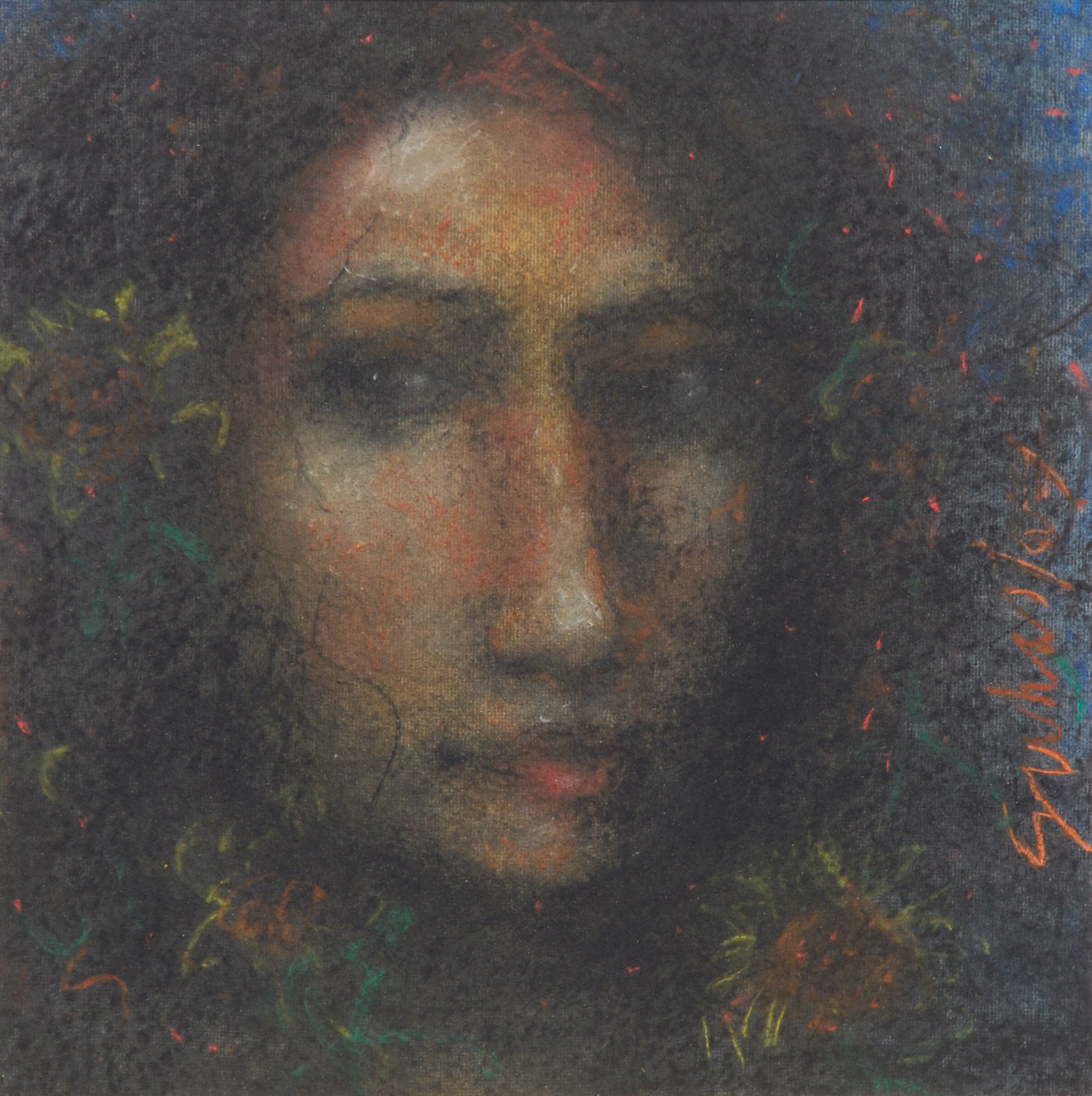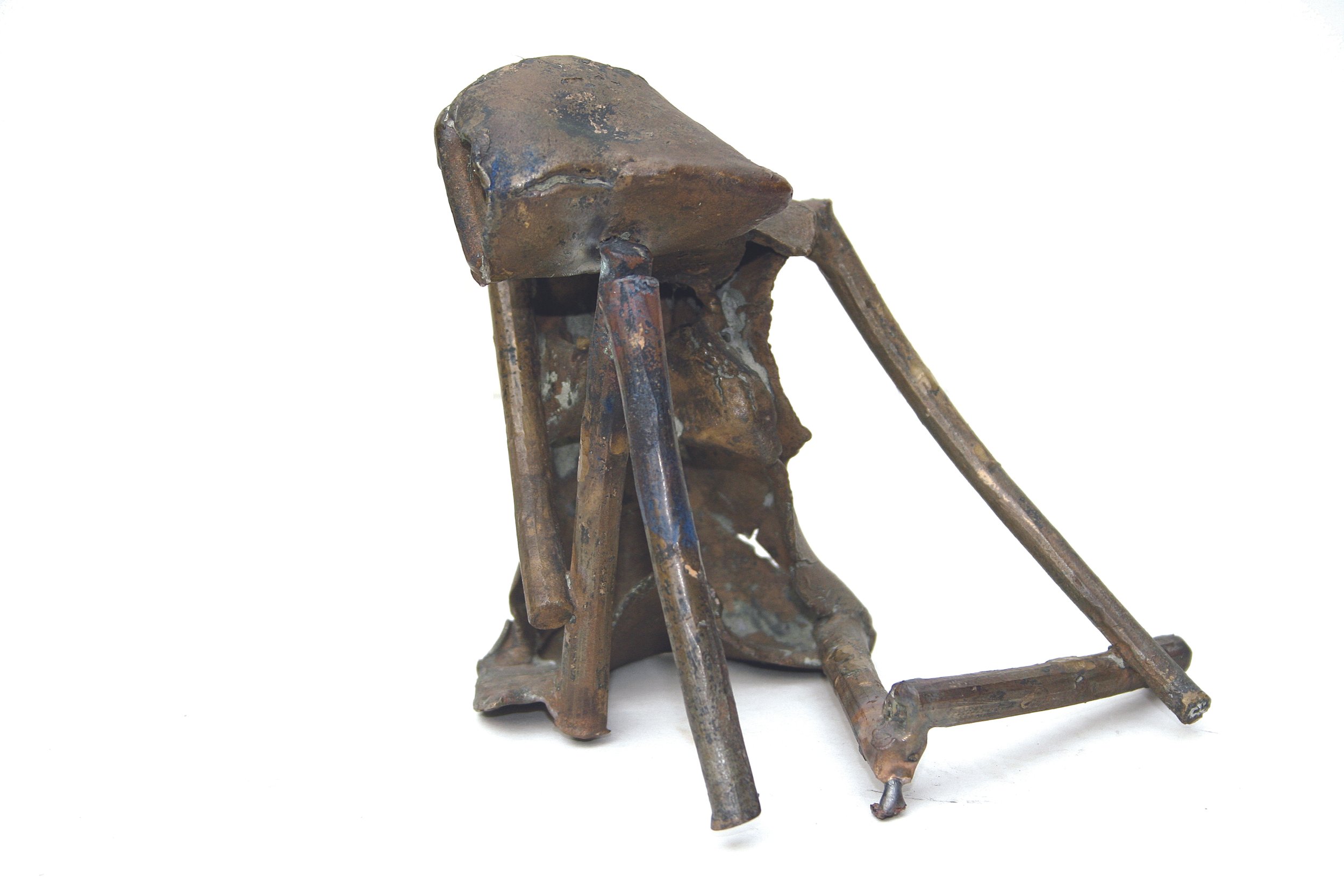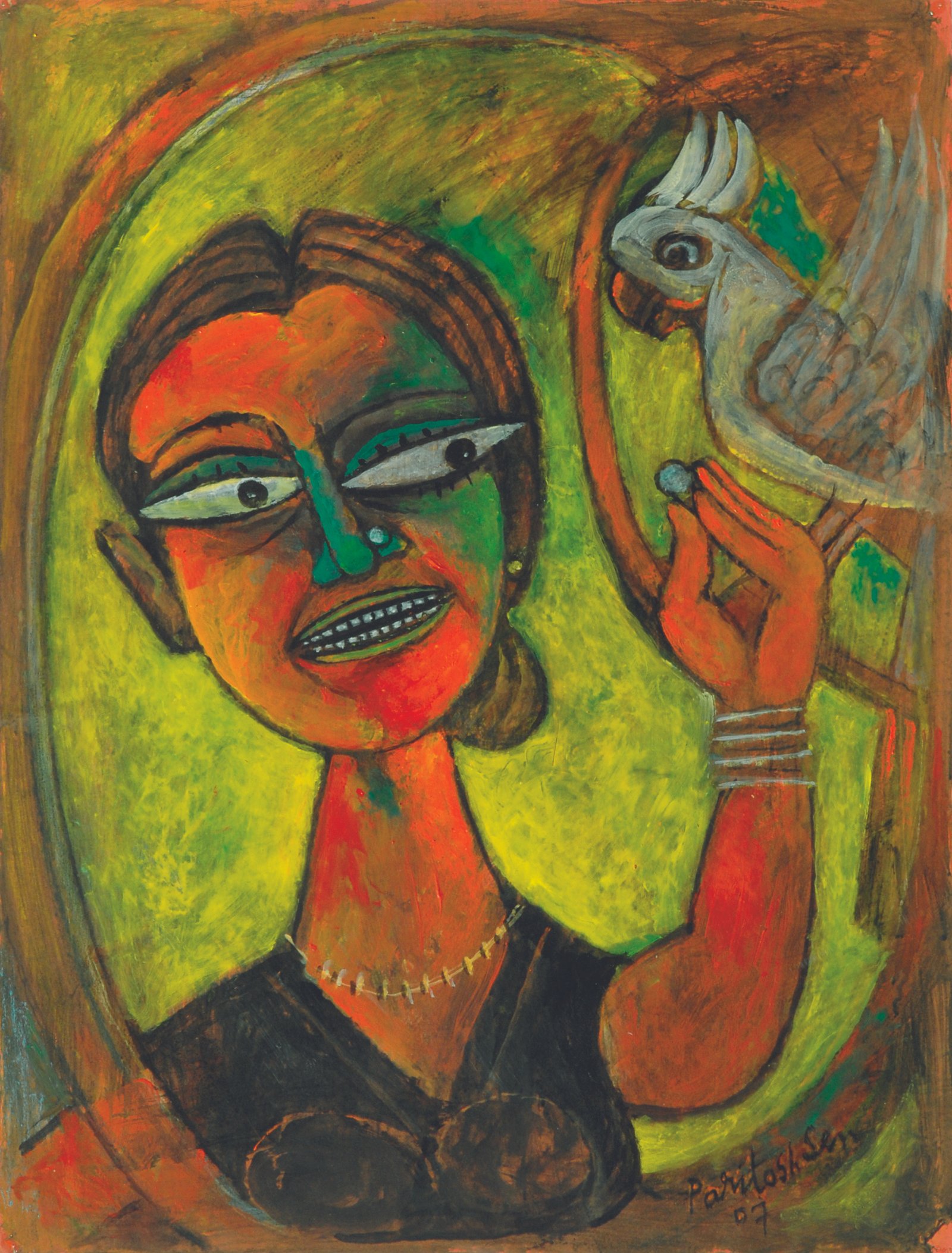
12 Artists
October 2007
Paritosh Sen (1918 - 2008)
Born in Dhaka (now Bangladesh) in 1918. Graduated at Govt. School of Art and Crafts, Madras, 1940. Between 1950-53, Paritosh Sen studied in Paris at Andre Lhote’s School, at the Academy Grand Chaumier, Ecole des Beaux Arts and at Ecole de Louvre (for History of Painting).
In 1943 he was one of the founder members of Calcutta Group. In 1962, he was invited by the French Government to design Bengali typeface based on the script of Rabindranath Tagore. In 1979 the Indo - Soviet Friendship Association exhibited his works in Moscow. During 1981-82 he spent time as a visiting professor at the Maryland Institute of Art, Baltimore, U. S. A. In 1986 he was Commissioner, Indian section of Havana Biennale II, Cuba. He was also invited to speak on Indian Contemporary Painting at Loomis Chaffee School by Allan Lundie Wise Lecture Fund, Windsor, Conn., U. S. A. later.
He was a member of General Council, LKA, New Delhi and also a member of Executive Council, Visva Bharati University, Santiniketan. He contributed numerous articles and books about contemporary art. In 2002, the French Government conferred him Officier de l’Ordre des Arts et des Lettres.
Somnath Hore (1921 - 2006)
Born in a village called Barama in Chittagong, now Bangladesh, in 1921.
He received his Diploma in Fine Arts from the Government College of Art & Craft. From 1954 to 1958 Hore was a lecturer at the Indian College of Art and Draughtsmanship in Calcutta. Thereafter, till 1967, he held posts like the “in-charge of the Graphic section” at the Delhi College of Art, visiting faculty at the MS University in Baroda and the head of the Graphic Art department of Kala Bhavan, Visva Bharati. In 1960, he became a member of the Society of Contemporary Artists.
Meera Mukherjee (1923 - 1998)
Born in Kolkata in 1923, Meera studied at the Indian Society of Oriental Art School, Kolkata and received a diploma in painting, graphics and sculpture from Delhi Polytechnic in 1947. In 1952 she worked under the Indonesian master Affandi, in Santiniketan, West Bengal for a year. Then in 1953 she studied painting, sculpture, etching and lithography at the Akademie de Bildenden Kunstem in Munich, W. Germany. From 1960 she started research on folk metal castings and the casting techniques of classical Indian sculptures. She was a senior research fellow with the Anthropological Survey of India.
She won the Kolkata Ladies’ Study Group Award in 1967, the Presidents' Award for master craftsmen in metal work in 1968 and the West Bengal Government’s Abanindranath Award in 1980. A few of her published works are, Folk Metalcraft in India (1978), Metal Craft in India (1978) and Metal Craftsmen in India (1979).
Sarbari Roy Choudhury (1933 – 2012)
Born in Ulpur, East Bengal (now Bangladesh). He graduated in Sculpture from the Government College of Art & Craft, Calcutta and Faculty of Fine Arts, Baroda.
During his study tour in Europe, Roy Choudhury visited Paris and Italy, and was able to meet two great masters, Alberto Giacometti and Ossip Zadkine, who appreciated his small bronzes. He studied sculpture at the Academia dei Belle Arti, Florence, Italy, interacting with Marino Marini and Henry Moore. Back in India, he joined the Department of Sculpture at Visva Bharati University, Santiniketan. He was a Connoisseur of Hindustani and Carnatic classical music and collected rare albums and recordings.
He has participated in the Paris Biennale in 1965.
His works are in the collections of the National Gallery of Modern Art, New Delhi and at The Madam Shenue Museum, Florence, Italy and in many private collections across the world.
Sanat Kar (b. 1935)
Born in Calcutta in 1935. Graduated from the Government College of Art and Craft, Calcutta in 1950.
In 1952, along with fellow-students Kar formed a group called The Artists’ Circle and became the Secretary of the group. He was the Head of Department of Graphic Art at Kala Bhavan, Visva Bharati in Santiniketan from 1976 to 1989. He retired as Professor and Principal from Kala Bhavan, Viswa Bharati in 1995.
Kar was a founder member of the Society of Contemporary Artists in 1960. He began experimenting with etching in the early ‘60s. He was the innovator of wood intaglio, engraving on sunmica and cardboard intaglio. From the late ‘80s began painting with tempera.
He has had several solo shows in India and overseas and participated in International Prints Biennale and travelling exhibitions in Europe, USA, USSR, Japan. He has been awarded with Kala Vibhusan National Title Award in 1997, Siromoni Purashkar in 1996 and West Bengal State Lalit Kala Award in 1993. Major collections of his works are in Lalit Kala Akademi, National Gallery of Modern Art, India and Glenberra Museum, Japan.
He lives and works in Santiniketan.
Ganesh Haloi (b. 1936)
Born in 1936 in Jamalpur, Mymensingh, now in Bangladesh, Haloi graduated from the Government College of Art and Craft, Calcutta in 1956. The next year he joined the Archaeological Survey of India to make copies of the Ajanta murals. After seven years, Haloi returned to Calcutta to work. From 1963 till his retirement, he taught at the Government College of Art and Craft. Since 1971, he has been a member of the Society of Contemporary Artists, Kolkata.
He has received several awards - Gold Medals at the Academy of Fine Arts six times between 1955 and 1970, the Rabindra Bharti Award in 1970 and the Siromoni Purashkar in 1991 amongst others.
Documentary Films have been made on him by Samir Dutta and Prasanta Daw for Calcutta Doordarshan, Govt. of West Bengal for state archives.
He lives and works in Kolkata.
Ganesh Pyne (1937 - 2013)
Ganesh Pyne was born in 1937 in Kolkata. He graduated from the Government College of Art and Craft, Calcutta in 1959. In 1963 he joined the Society for Contemporary Artists. He regularly participated in the annual exhibition of the society till the late '80's.
Pyne was given the Raja Ravi Varma award by the Government of Kerala in 2011 and the lifetime achievement award by the Indian Chamber of Commerce in 2012. He led a quiet and reclusive life. His first solo exhibition was only held after he was 50 at The Village Gallery in Delhi. He has participated in many prestigious group shows and his work is part of many public and private collections. His work has been showcased in Paris Biennial, Paris in 1970, Hirschhorn Museum, Washington DC in 1982, Darmdstadt, Germany in 1982 & 1986 and Singapore Art Museum, Singapore in 1997 to name a few. There are many books published on his art and life.
Jogen Chowdhury (b. 1939)
Born in Daharpara Village, Faridpur, Bangladesh in 1939. He graduated from the Government College of Art and Craft, Kolkata.
In 1970, he joined ‘Calcutta Painters’ group while the same year a collection of his poems were published. From 1973 to 1987, he was appointed as a Curator in the Art Gallery, Rashtrapati Bhavan, New Delhi. In 1986, he represented India in the ‘Festival of Art’ in Baghdad, Iraq. He also participated in the ‘Festival of India’ in London (1982) and Paris (1985). His work has been exhibited extensively in India and internationally in USA, Japan, Mexico, Switzerland and France.
In 1966, Chowdhury was awarded the Prix le France de la Jeune Peinture in Paris, and, in 1986, received an award at the Second Biennale of Havana, Cuba. He was presented the Kalidas Sanman by the Government of Madhya Pradesh in 2001. His work can be seen in many public and private collections in India and abroad including the National Gallery of Modern Art and Lalit Kala Akademi, New Delhi, Singapore Art Museum, Singapore, Victoria and Albert Museum, London.
He lives and works in Santiniketan.
Suhas Roy (1926-2016)
Suhas Roy's preoccupation is primarily with the female face and form, and his subjects are romanticised, inhabiting the dreamlike world between sensuality and innocence. His work is usually inspired by life around him, but his themes are as much influenced by the everyday world as they are rooted in fantasy. The vast and complex texture of life is seen as mystical and dark in his work. The mystical flavour of his works arose from his interpretations of the 'unknown'.
Suhas Roy he studied at the Indian College of Arts and Draftsmanship, Calcutta, and under the tutelage of Prof. S.W. Hayter at the Atelier 17 Ecole Superior Des Beaux Arts, Paris. His works have been exhibited all over the world through exhibitions like the Asian Graphic Prints Traveling Exhibition, USA, the Tokyo Print Biennale, Japan, Contemporary Indian Art, Yugoslavia, Romania, Czechoslovakia, Hungry, and Wounds, at the Central Institute Modern Art, New Delhi, and the National Gallery of Modern Art, New Delhi. Roy lives and works in Santiniketan where he is the head of the Department of Painting at Kala Bhavan, Santiniketan.
Bikash Bhattacharjee (1940-2006)
Born in Kolkata in 1940, Bikash Bhattacharjee lost his father at a very early age. In 1963, he graduated from Indian College of Art and Draftsmanship. He joined the same college as professor in 1968. From 1973, Bhattacharjee began teaching at the Government College of Arts and Crafts and taught there till 1982.
Bhattacharjee drew inspiration for his work from his early dreary days, where vivid images of his struggling - the crumbling walls of buildings and the multitudes of people living there - wove a certain magic in his mind. His drawings form a fitting introduction to his paintings, forms that are consist in terms of tone rather than line. Bhatacharjee carefully expresses the textural effects of crayons, pastels and pencil using the combination of highlights and depths of passages built of varying intensities of line. Improbable characters (both psychologically and physiologically) play a role on the canvas and dominate his oils. His subject is always clear, recognizable, painted with faithfulness to detail and invested with a sense of the dramatic. Female beauty is a major preoccupation with him with a strange mixture of spirituality and sensuality. The ability to create an authentic milieu as a background to the characters heightens the drama. The artist explores the possibilities of oil as a medium and can depict the exact quality of drapery or the skin tone of a woman, the peeling walls of an old building. He had also achieved mastery over the capturing of the quality of light, an effect that lends his work a superb realism as well as an enigmatic quality. Bhattacharjee is also known for his Kolkata cityscapes that he worked on in his twenties.
The artist passed away in 2006.
Shyamal Dutta Ray(1934 – 2005)
Shyamal Dutta Ray's body of work constitutes a major turning point in the history of the Bengal school of art. Ray is credited with adding depth and intensity to the medium of watercolours, at a time when the Bengal school of Art traditionally used light and watery colours. His melancholic and pensive works reflect the contradictions of life around him.
Regarded as a master watercolourist, Ray is also a founding member of the Society of Contemporary Artists, an artists' collective, that sought to introduce innovativeness into the art world of the 1960s. Most of Ray's work reflects the city life of Calcutta, with its happiness and sorrow, struggle and strife, poverty and hope. The works also exhibit a sense of irony, surrealism and awareness of a disintegrating society.
Shyamal Dutta Ray studied at the Government College of Arts and Crafts, Calcutta. He has received many honours: the Award of Merit from the Lalit Kala Academy, the Shiromani Kala Puraskar, and the Special Commendation of the Karnataka Chitrakala Parishad. His works have been exhibited in Mumbai, Delhi, Calcutta and Bangalore. He has participated in international shows such as the Third World Biennale of Graphics, London, and the Havana Biennale, Cuba, to mention a few. His works are in the collections of the National Gallery of Modern Art, Delhi, the Victoria and Albert Museum, London and the Glenbarra Museum, Japan.
The Artist passed away on 19th May 2005.
Shyamal Dutta Ray | Untitled | Watercolor on paper | 15.5 x 12 in
Paritosh Sen | Woman with cat | Acrylic on the mountboard | 60 x 40 in
Jogen Chaudhary | Nude Study | Dry pastel on paper | 22 x 30 in
Jogen Choudhary | Two women | mixed media on paper | 21 x 29 in
Jogen Choudhary | Woman in Saree | Charcoal on paper | 20 x 28 in
Ganesh Pyne | Mask | Tempera on paper | 22 x 17 in
Bikash Bhattacharya | Untitled | Dry pastel on paper | 34 x 21.25 in
Bikash Bhattacharya | Study of a boy | Dry pastel on paper | 29 x 19 in
Bikash Bhattacharya | Nude Study | Dry pastel on paper | 29 x 19 in
Amitabh Banerjee | Wondering | Pastel on paper | 17 x 27 in
Amitabh Banerjee | Holy man | Pastel on paper | 16 x 11.5 in
Amitabh Banerjee | Untitled | Acrylic on canvas | 36 x 40 in
Suhas Roy | Radha III | Mixed media on paper | 33 x 25 in
Suhas Roy | Radha II | Mixed media on paper | 22 x 15 in
Somnath Hore | Untitled | Bronze | 5.5 in
Somnath Hore | Untitled | Pen & ink on paper | 10.75 x 9.75 in
Somnath Hore | Untitled | Pen & ink on paper | 9.75 x 10.75 in
Shyamal Dutta Ray| Untitled | Watercolor on paper | 16.5 x 21.5 in
Sarbari Roy Chaudhary | Bade Ghulam Ali | Bronze | 11 in
Sarbari Roy Chaudhary | Sohini | Bronze | 8.5 in
Sanat Kar | Ikebana Part V | Oil on canvas | 36 x 27 in
Sanat Kar | Ikebana Part V | Oil on canvas | 36 x 27 in
Sanat Kar | Ikebana Part V | Oil on canvas | 36 x 27 in
Paritosh Sen | Woman in the rain | Acrylic on the mountboard | 29.5 x 24 in
Paritosh Sen | Woman with Cockatoo | Acrylic on the mountboard | 30.5 x 23 in
Meera Mukherjee | Untitled | Bronze | 13 in
Meera Mukherjee | Untitled | Bronze | 10 in
Meera Mukherjee | Untitled | Bronze | 11 in
Ganesh Haloi | Untitled | Gouache on handmade paper | 14 x 16 in
Ganesh Haloi | Untitled | Gouache on handmade paper | 14 x 16 in





























